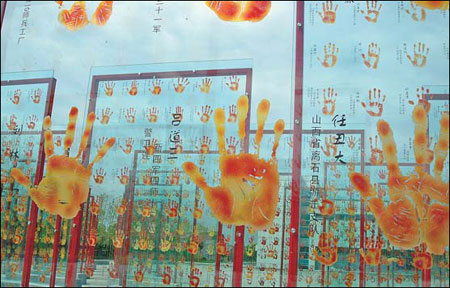Quiet! History speaking
 |
|
Bloodied palm prints signify the ravages of war. [Photo: China Daily ] |
One of his most unusual items, a living, breathing reminder of the 2008 Sichuan earthquake, is a pig that had been buried under the rubble for more than 40 days. Fan bought it, named it Zhu Jianqiang or Mr Piggy the Determined, and the animal now takes pride of place in his Sichuan Earthquake Memorial Museum. In a sadder tribute, he also co-built the Hu Huishan Memorial Hall in memory of a 15-year-old earthquake victim.
But the collection that tugs at Fan's heart the most is the cluster of five museums he has built to commemorate the War of Resistance against Japanese Aggression (1937-45). Saturday was the 79th anniversary of the historic Sept 18 incident in 1931, when the invading Japanese army blew up part of a railroad owned by a Japanese colonial company near Mukden (now Shenyang), and used the incident as a pretext for larger-scale war against China.
Fan grew up listening to the stories of how his father, a military veteran, fought off Japanese invaders. During the 11 years that Fan himself served in the People's Liberation Army, his interest in China's campaigns during World War II grew.
In the 1990s, he started to collect artifacts of war while he first worked at a foreign-financed company and later as a real estate agent.
Since then he has been flying to Japan often, searching for and buying original evidence of war crimes. His collection over the past decade is now estimated at more than 100,000 items, ranging from old firearms, combat charts, military intelligence and files, magazines and posters, posthumous papers, diaries and photographs of Japanese soldiers.
His latest purchases include a stack of more than 1,000 letters that a low-ranking military official wrote to his families, relatives and friends in Japan in the one year before the war ended. This soldier was in charge of cremating comrades who had died on the battlefield.
As he delves into these official documents and individual memories, Fan is beginning to see a complete picture of the Japanese story.
"Almost all public exhibitions display evidence of the invaders' cruelty, underlining their policies of 'slaughter, burn and pillage'. Historical files I found in Japan indicated that the Japanese were also disciplined," which also explains the organized crime by a state entity.
The historical data he found showed that the Japanese army had been cobbled together from a hodgepodge of social classes. For instance, one unit of mineworkers could fight violently while another unit of urban merchants knew little of combat strategies.
 0
0 







Go to Forum >>0 Comments